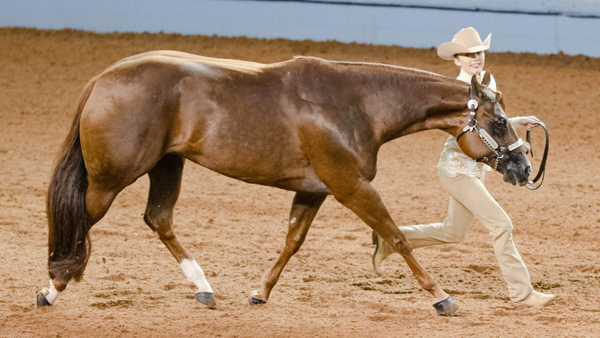Think About Temperament
Showmanship is all about creating a presence in the ring. You want to present yourself confidently and happily. Your horse can’t have his ears pinned or his tail swishing. That’s why a good showmanship partner has a happy-go-lucky personality.
“I like them to have an outstanding, happy, willing personality,” Vroegh said. “One thing about the showmanship is their ability to be light and move and do things, but it’s also an overall picture. It’s a presence out there, and if you have one that doesn’t enjoy their job and pins their ears, you have a hard time having the presence that you want — especially if they’re a little pin-eared or snarky.”
To get that smooth, precise presence, your horse has to be able to tune into you and be sensitive, which Vroegh often finds in mares.
“The biggest thing for me is that they can’t just be a big, dumb gelding,” she said. “They have to have a little bit of sensitivity to them because they can’t be heavy.”
A Perfect Match
There’s no such thing as a perfect showmanship horse — but there is an ideal showmanship partnership. Showmanship is like a dance between horse and handler; therefore, the two must be matched up well.
“How sensitive they are depends on the handler,” Vroegh said. “I can’t say that I can pick (a good showmanship horse) just based on the horse itself. It has to fit the exhibitor.”
Vroegh went more into depth about the details and how to ensure that the horse/handler duo is perfect. “If I have a handler that is a little high strung and gets a little bit nervous, I want a horse that’s a little duller,” she said. “But if I have someone who’s super confident and can help through things, then I can have a horse that has a little more spice to it.”
Practice, Practice, Practice
When it comes to showmanship, you can’t over practice—the more time spent next to your horse, the better.
“There are other classes where I can say, ‘You need to let me spend time with the horse as your horse trainer,’” Vroegh said. “I don’t think you can over practice or overspend time with your animal when it comes to showmanship. They know when it’s you, they know when it’s me. They’re right there eye-to-eye with you.”
Spending time practicing with your horse allows both of you to get to know each other better — how many strides you need to take to hit a cone to a hip or what your body language looks like when you’re stopping.
“When it comes to things like hitting your hip and doing the pieces, you have to know that stuff — you have to know that your horse is big, so you can’t back very far,” she said. “You have to be able to know that about your animal.”
Showmanship is a precise, challenging class that can come down to single or half points. Making sure that you’re picking the right partner and then growing that partnership will allow you to thrive and succeed in the class.
“When the judge sees you come in and they see you have a presence about you and it looks like you’re literally in time with your horse, the judge knows. He knows you have a great showmanship horse,” Vroegh said. “The real, true thing that tells someone that you’re out there and doing well is the confidence and compatibility of you and your horse. That’s what makes a judge wake up and say, ‘This is a good team.’”









